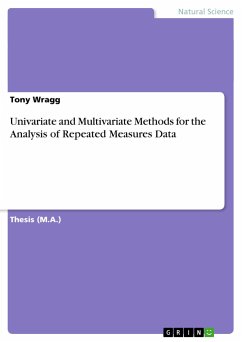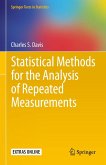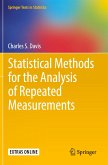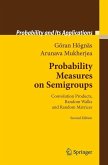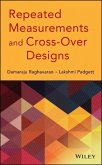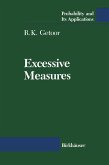- Gebundenes Buch
- Merkliste
- Auf die Merkliste
- Bewerten Bewerten
- Teilen
- Produkt teilen
- Produkterinnerung
- Produkterinnerung
This book aims to steer the reader through a pool of techniques available for analysing repeated measurements. It describes an appropriately random selection of examples in connection with the various statistical methods.
Andere Kunden interessierten sich auch für
![Univariate and Multivariate Methods for the Analysis of Repeated Measures Data Univariate and Multivariate Methods for the Analysis of Repeated Measures Data]() Tony WraggUnivariate and Multivariate Methods for the Analysis of Repeated Measures Data42,95 €
Tony WraggUnivariate and Multivariate Methods for the Analysis of Repeated Measures Data42,95 €![Statistical Methods for the Analysis of Repeated Measurements Statistical Methods for the Analysis of Repeated Measurements]() Charles S. DavisStatistical Methods for the Analysis of Repeated Measurements38,99 €
Charles S. DavisStatistical Methods for the Analysis of Repeated Measurements38,99 €![Statistical Methods for the Analysis of Repeated Measurements Statistical Methods for the Analysis of Repeated Measurements]() Charles S. DavisStatistical Methods for the Analysis of Repeated Measurements38,99 €
Charles S. DavisStatistical Methods for the Analysis of Repeated Measurements38,99 €![Probability Measures on Semigroups Probability Measures on Semigroups]() Göran HögnäsProbability Measures on Semigroups106,99 €
Göran HögnäsProbability Measures on Semigroups106,99 €![Probability Measures on Semigroups Probability Measures on Semigroups]() Göran HögnäsProbability Measures on Semigroups106,99 €
Göran HögnäsProbability Measures on Semigroups106,99 €![Repeated Measurements Repeated Measurements]() Damaraju RaghavaraoRepeated Measurements128,99 €
Damaraju RaghavaraoRepeated Measurements128,99 €![Excessive Measures Excessive Measures]() R. K. GetoorExcessive Measures39,99 €
R. K. GetoorExcessive Measures39,99 €-
-
-
This book aims to steer the reader through a pool of techniques available for analysing repeated measurements. It describes an appropriately random selection of examples in connection with the various statistical methods.
Produktdetails
- Produktdetails
- Verlag: Routledge
- Seitenzahl: 268
- Erscheinungstermin: 1. Mai 1990
- Englisch
- Abmessung: 222mm x 145mm x 18mm
- Gewicht: 472g
- ISBN-13: 9780412318306
- ISBN-10: 041231830X
- Artikelnr.: 21685438
- Herstellerkennzeichnung
- Libri GmbH
- Europaallee 1
- 36244 Bad Hersfeld
- gpsr@libri.de
- Verlag: Routledge
- Seitenzahl: 268
- Erscheinungstermin: 1. Mai 1990
- Englisch
- Abmessung: 222mm x 145mm x 18mm
- Gewicht: 472g
- ISBN-13: 9780412318306
- ISBN-10: 041231830X
- Artikelnr.: 21685438
- Herstellerkennzeichnung
- Libri GmbH
- Europaallee 1
- 36244 Bad Hersfeld
- gpsr@libri.de
Crowder\, Martin J.; Hand\, David J.
Acknowledgements
Preface
1 Introduction
1.1 Background and objectives
1.2 Overview
2 Some simple analyses
2.1 Comparisons at individual times
2.2 Response feature analysis
2.3 Individual curve fitting
2.4 Further reading
3 Univariate analysis of variance
3.1 The fundamental model
3.2 Anova
3.3 Calculation of expected mean
squares
3.4 Expected mean
squares by 'synthesis'
3.5 Contrasts, compound symmetry and F
tests
3.6 Relaxing assumptions: univariate, modified univariate, or multivariate tests?
3.7 Further reading
4 Multivariate analysis
4.1 Models without special covariance structure
4.2 Hotelling's T2
4.3 Testing for polynomial trends
4.4 Manova
4.5 Further reading
5 Regression models
5.1 Special case
5.2 General case
5.3 Structured covariance case
5.4 Some covariance structures
5.5 Further reading
6 Two
stage linear models
6.1 Random regression coefficients
6.2 Estimation and testing
6.3 Particular aspects
6.4 Examples
6.5 Further reading
7 Crossover experiments
7.1 Simple 2 x 2 designs
7.2 A Bayesian approach to 2 x 2 designs
7.3 More complex crossover designs for two treatments
7.4 Crossover trials with a binary response
7.5 Further topics
7.6 Further reading
8 Categorical data
8.1 Introduction
8.2 Markov chain models
8.3 Log
linear models
8.4 Linear model methods for group and time comparisons
8.5 Randomization test approaches
8.6 Some special cases
8.7 Further reading
9 Some further topics
9.1 Some practical matters
9.2 Antedependence
9.3 Tracking
9.4 Nonlinear growth curves
9.5 Non
normal observations
10 Computer software and examples
10.1 Repeated measures facilities in BMDP, SPSS' and SAS
10.2 Example 1
BMDP program 2V
10.3 Example 2
BMDP program 2V
10.4 Example 3
BMDP program 2V
10.5 Example 4
SPSS' program MANOVA
10.6 Example 5
SPSS' program MANOVA
10.7 Example 6
BMDP program 5V
Bibliography /Supplementary References
Index.
Preface
1 Introduction
1.1 Background and objectives
1.2 Overview
2 Some simple analyses
2.1 Comparisons at individual times
2.2 Response feature analysis
2.3 Individual curve fitting
2.4 Further reading
3 Univariate analysis of variance
3.1 The fundamental model
3.2 Anova
3.3 Calculation of expected mean
squares
3.4 Expected mean
squares by 'synthesis'
3.5 Contrasts, compound symmetry and F
tests
3.6 Relaxing assumptions: univariate, modified univariate, or multivariate tests?
3.7 Further reading
4 Multivariate analysis
4.1 Models without special covariance structure
4.2 Hotelling's T2
4.3 Testing for polynomial trends
4.4 Manova
4.5 Further reading
5 Regression models
5.1 Special case
5.2 General case
5.3 Structured covariance case
5.4 Some covariance structures
5.5 Further reading
6 Two
stage linear models
6.1 Random regression coefficients
6.2 Estimation and testing
6.3 Particular aspects
6.4 Examples
6.5 Further reading
7 Crossover experiments
7.1 Simple 2 x 2 designs
7.2 A Bayesian approach to 2 x 2 designs
7.3 More complex crossover designs for two treatments
7.4 Crossover trials with a binary response
7.5 Further topics
7.6 Further reading
8 Categorical data
8.1 Introduction
8.2 Markov chain models
8.3 Log
linear models
8.4 Linear model methods for group and time comparisons
8.5 Randomization test approaches
8.6 Some special cases
8.7 Further reading
9 Some further topics
9.1 Some practical matters
9.2 Antedependence
9.3 Tracking
9.4 Nonlinear growth curves
9.5 Non
normal observations
10 Computer software and examples
10.1 Repeated measures facilities in BMDP, SPSS' and SAS
10.2 Example 1
BMDP program 2V
10.3 Example 2
BMDP program 2V
10.4 Example 3
BMDP program 2V
10.5 Example 4
SPSS' program MANOVA
10.6 Example 5
SPSS' program MANOVA
10.7 Example 6
BMDP program 5V
Bibliography /Supplementary References
Index.
Acknowledgements
Preface
1 Introduction
1.1 Background and objectives
1.2 Overview
2 Some simple analyses
2.1 Comparisons at individual times
2.2 Response feature analysis
2.3 Individual curve fitting
2.4 Further reading
3 Univariate analysis of variance
3.1 The fundamental model
3.2 Anova
3.3 Calculation of expected mean
squares
3.4 Expected mean
squares by 'synthesis'
3.5 Contrasts, compound symmetry and F
tests
3.6 Relaxing assumptions: univariate, modified univariate, or multivariate tests?
3.7 Further reading
4 Multivariate analysis
4.1 Models without special covariance structure
4.2 Hotelling's T2
4.3 Testing for polynomial trends
4.4 Manova
4.5 Further reading
5 Regression models
5.1 Special case
5.2 General case
5.3 Structured covariance case
5.4 Some covariance structures
5.5 Further reading
6 Two
stage linear models
6.1 Random regression coefficients
6.2 Estimation and testing
6.3 Particular aspects
6.4 Examples
6.5 Further reading
7 Crossover experiments
7.1 Simple 2 x 2 designs
7.2 A Bayesian approach to 2 x 2 designs
7.3 More complex crossover designs for two treatments
7.4 Crossover trials with a binary response
7.5 Further topics
7.6 Further reading
8 Categorical data
8.1 Introduction
8.2 Markov chain models
8.3 Log
linear models
8.4 Linear model methods for group and time comparisons
8.5 Randomization test approaches
8.6 Some special cases
8.7 Further reading
9 Some further topics
9.1 Some practical matters
9.2 Antedependence
9.3 Tracking
9.4 Nonlinear growth curves
9.5 Non
normal observations
10 Computer software and examples
10.1 Repeated measures facilities in BMDP, SPSS' and SAS
10.2 Example 1
BMDP program 2V
10.3 Example 2
BMDP program 2V
10.4 Example 3
BMDP program 2V
10.5 Example 4
SPSS' program MANOVA
10.6 Example 5
SPSS' program MANOVA
10.7 Example 6
BMDP program 5V
Bibliography /Supplementary References
Index.
Preface
1 Introduction
1.1 Background and objectives
1.2 Overview
2 Some simple analyses
2.1 Comparisons at individual times
2.2 Response feature analysis
2.3 Individual curve fitting
2.4 Further reading
3 Univariate analysis of variance
3.1 The fundamental model
3.2 Anova
3.3 Calculation of expected mean
squares
3.4 Expected mean
squares by 'synthesis'
3.5 Contrasts, compound symmetry and F
tests
3.6 Relaxing assumptions: univariate, modified univariate, or multivariate tests?
3.7 Further reading
4 Multivariate analysis
4.1 Models without special covariance structure
4.2 Hotelling's T2
4.3 Testing for polynomial trends
4.4 Manova
4.5 Further reading
5 Regression models
5.1 Special case
5.2 General case
5.3 Structured covariance case
5.4 Some covariance structures
5.5 Further reading
6 Two
stage linear models
6.1 Random regression coefficients
6.2 Estimation and testing
6.3 Particular aspects
6.4 Examples
6.5 Further reading
7 Crossover experiments
7.1 Simple 2 x 2 designs
7.2 A Bayesian approach to 2 x 2 designs
7.3 More complex crossover designs for two treatments
7.4 Crossover trials with a binary response
7.5 Further topics
7.6 Further reading
8 Categorical data
8.1 Introduction
8.2 Markov chain models
8.3 Log
linear models
8.4 Linear model methods for group and time comparisons
8.5 Randomization test approaches
8.6 Some special cases
8.7 Further reading
9 Some further topics
9.1 Some practical matters
9.2 Antedependence
9.3 Tracking
9.4 Nonlinear growth curves
9.5 Non
normal observations
10 Computer software and examples
10.1 Repeated measures facilities in BMDP, SPSS' and SAS
10.2 Example 1
BMDP program 2V
10.3 Example 2
BMDP program 2V
10.4 Example 3
BMDP program 2V
10.5 Example 4
SPSS' program MANOVA
10.6 Example 5
SPSS' program MANOVA
10.7 Example 6
BMDP program 5V
Bibliography /Supplementary References
Index.



